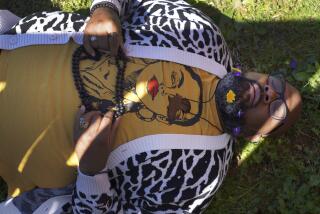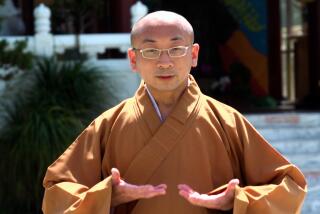Modernity Affects Tibetan Hermits
- Share via
DHARMSALA, India — Atop a steep slope overlooking this mountainous retreat is the hut of a Buddhist hermit, festooned with flags of prayer.
Spring breezes puff through the evergreens. The flags flap. As they do, says Tibetan lore, prayers inscribed on the sun-bleached cloth are released.
Outside it is peaceful, but inside the hut agitation reigns.
Jampa Tenzin, the hermit, fiddles with the cap on a can of “Springtime” air freshener. He says the number of Buddhist recluses is dwindling and their culture, once held in awe by Tibetans, is dying.
“This is an age of degeneration,” he declared, passing a visitor a cup of Tang orange drink. “We have no right to compare ourselves to the saints of the past.
“Today’s mind is always thinking. We have no time to really do anything, always skipping from this and that.”
This day, Tenzin is also pressed for time. He is about to set out on the hourlong journey to the town below to ready a water pump for his hermitage.
A water pump?
What’s that got to do with nirvana, and what’s Tenzin doing with Tang and Springtime air freshener?
“Times have changed,” he said.
Their predecessors abandoned the material world for lonely crags and caves in their homeland, but today’s Tibetan hermits are slowly embracing creature comforts.
From thousands in Tibet, the Buddhist hermits have dwindled to a mere 50 around Dharmsala, headquarters of the Dalai Lama’s exile government.
Some hermits remain in Tibet, although their numbers dropped precipitously during China’s Cultural Revolution in 1966-1976, when bands of Red Guards routinely killed Tibetan monks.
Most hermits fled Tibet with the Dalai Lama, their spiritual leader, after an abortive uprising in 1959.
At that time, many ended their isolation. For those who have remained in the woods, the pursuit of enlightenment is more difficult.
“Modernity touches us and it’s very hard to resist,” Tenzin said. “Comfort makes us lose discipline. We become soft.”
Few, if any, of Dharmsala’s hermits are capable of following the rigorous lifestyle of earlier hermits, he said.
The fabled 11th-Century hermit Milarepa spent decades meditating in snowbound caves. Legends say a diet of nettles turned him green.
Today’s hermits meditate for barely half the day, Tenzin said.
Most also appear well-fed. Tenzin is quite rotund. His happy round face has a double chin.
His hut is filled with books, a sturdy kerosene stove, electric lamps, jars of dried fruit and packets of chocolate-drink mix.
Tenzin, 54, became a hermit 20 years ago. He entered the Tibetan Buddhist clergy when he was 7 and studied scriptures for the next 14 years in a monastery near his upper-class family’s home in southern Tibet.
He fled Tibet with the Dalai Lama and, after several more years of study, decided to abandon the material world to seek enlightenment.
Enlightenment, or Buddhahood, is described as a state of “no-mind” where the vagaries of everyday existence do not affect the core of a person’s being.
About 50 other monks joined him in hills above Dharmsala, supported by monthly stipends of about $10 from the Dalai Lama’s office and donations from Tibetans and Westerners.
Tenzin succeeded in mastering an advanced form of meditation in which the body temperature is raised. In 1981, Herbert Benson, a Harvard University medical professor, studied him and several other hermits.
Benson recorded a rise of between 7 and 15 degrees Fahrenheit in the skin temperature, particularly on the fingers and toes.
Since the early 1980s, Tenzin said, his abilities have deteriorated.
“The pursuit of nirvana is more difficult when all these things line the way,” he said.
More to Read
Sign up for Essential California
The most important California stories and recommendations in your inbox every morning.
You may occasionally receive promotional content from the Los Angeles Times.










